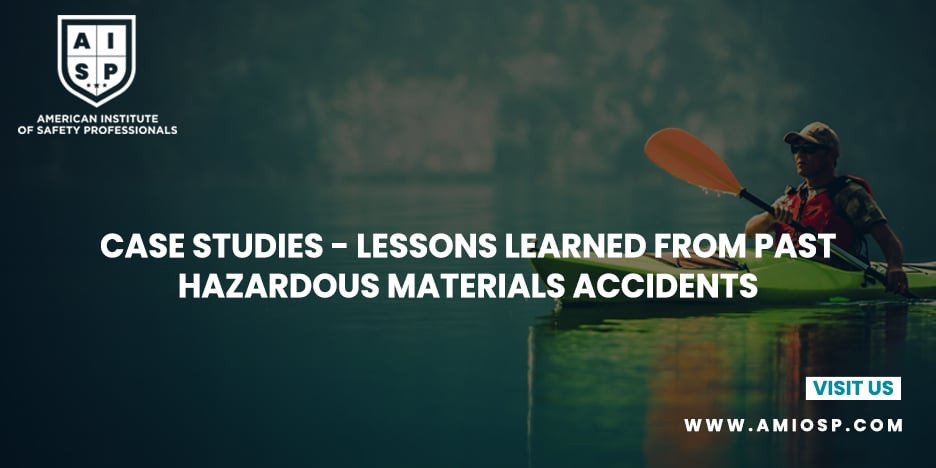Learning from past incidents is essential for improving
safety and preventing future accidents. In the context of hazardous materials
handling, studying case studies provides valuable insights into the causes,
consequences, and mitigation strategies related to accidents involving
hazardous materials. In this blog post, we will examine several case studies
and highlight the lessons learned from each incident.
1. The Importance of Case Studies in
Hazardous Materials Management
Case studies offer a practical and real-world perspective on
the challenges and risks associated with hazardous materials handling. By
analyzing past incidents, we can identify common trends, root causes, and best
practices for preventing and mitigating accidents. The lessons learned from
these case studies help inform safety protocols, regulations, and employee
training programs.
2. Bhopal Gas Tragedy
The Bhopal gas tragedy, which occurred in 1984 in India,
remains one of the most devastating industrial accidents in history. A
pesticide manufacturing plant released a toxic gas, methyl isocyanate (MIC),
into the surrounding community, resulting in the loss of thousands of lives and
long-term health impacts. Key lessons learned from this incident include:
- Importance
of Process Safety: The Bhopal tragedy highlighted the criticality of
process safety management, including proper maintenance, monitoring, and
training to prevent catastrophic releases.
- Community
Preparedness: Prompt and effective emergency response, including
community preparedness and communication, is vital for minimizing the
impact on surrounding areas.
- Regulatory
Oversight: This incident emphasized the need for robust regulatory
frameworks and enforcement to ensure compliance with safety standards in
hazardous industries.
3. Deepwater Horizon Oil Spill
The Deepwater Horizon oil spill, which occurred in 2010 in
the Gulf of Mexico, demonstrated the environmental and economic consequences of
a large-scale hazardous materials incident. The explosion and subsequent oil
spill from the offshore drilling rig had severe impacts on marine life, coastal
ecosystems, and local communities. Lessons learned from this incident include:
- Risk
Assessment and Contingency Planning: Thorough risk assessments and
comprehensive contingency plans are crucial to identify potential hazards
and implement proactive measures to prevent and respond to incidents.
- Effective
Communication and Collaboration: Timely and transparent communication
between all stakeholders, including government agencies, industry, and
environmental organizations, is essential for coordinating response
efforts and minimizing the impacts of a hazardous materials incident.
- Technological
Advancements: The Deepwater Horizon incident highlighted the need for
continued research and development of advanced technologies for offshore
drilling and containment of oil spills.
4. Chornobyl Nuclear Disaster
The Chornobyl nuclear disaster, which occurred in 1986 in
Ukraine, remains one of the most catastrophic accidents in the history of
nuclear power. The explosion and subsequent release of radioactive materials
had far-reaching consequences for human health and the environment. Key lessons
learned from this incident include:
- Safety
Culture and Training: A strong safety culture, supported by
comprehensive training programs, is essential in high-risk industries such
as nuclear power. This includes regular drills, continuous learning, and
strict adherence to safety protocols.
- Design
and Operational Safeguards: The Chornobyl disaster highlighted the
importance of robust design and operational safeguards, including multiple
layers of protection, fail-safe mechanisms, and emergency shutdown
procedures.
- International
Cooperation: This incident emphasized the need for international
cooperation in sharing knowledge, resources, and expertise to address the
potential cross-border impacts of hazardous materials accidents.
5. Applying Lessons Learned: Improving Hazardous
Materials Management
The lessons learned from past hazardous materials incidents
provide valuable insights for improving hazardous materials management.
Organizations can take the following steps to apply these lessons effectively:
- Risk
Assessment and Management: Conduct comprehensive risk assessments to
identify potential hazards, evaluate vulnerabilities, and implement
appropriate risk management strategies.
- Training
and Education: Provide regular training and education programs for
employees to enhance their understanding of hazardous materials, safety
protocols, and emergency response procedures.
- Continuous
Improvement: Foster a culture of continuous improvement by encouraging
reporting of near-miss incidents, conducting thorough investigations, and
implementing corrective actions to prevent future accidents.
- Regulatory
Compliance: Comply with relevant regulations and standards governing
the handling, storage, and transportation of hazardous materials to ensure
a high level of safety and minimize the risk of incidents.
6. Conclusion: Learning from the Past to Shape a Safer
Future
Case studies of past hazardous materials accidents serve as
powerful tools for learning and improving safety practices. By analyzing these incidents,
understanding the root causes, and implementing the lessons learned,
organizations can strengthen their hazardous materials management systems,
protect the environment, and safeguard the well-being of their employees and
surrounding communities. The collective effort to learn from the past ensures a
safer future for hazardous materials handling.












0 comments
No Comments